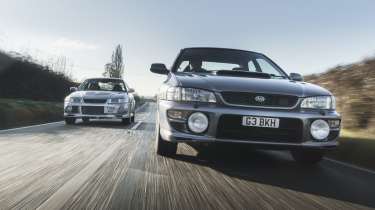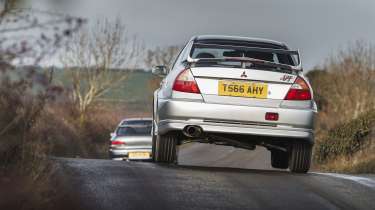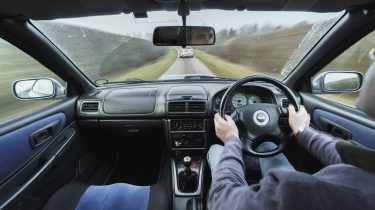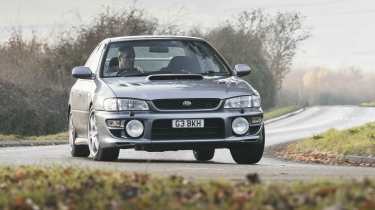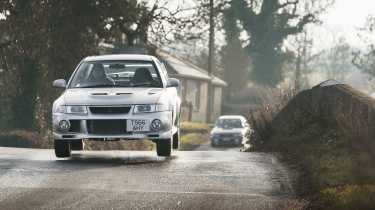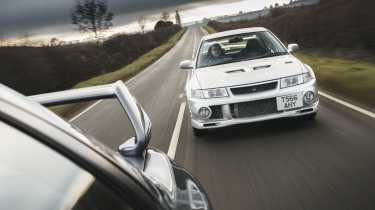Mitsubishi Lancer Evolution VI GSR v Subaru Impreza RB5 WR Sport – homologation heroes go head-to-head
Enemies both on the stages and off, Mitsubishi’s Lancer Evo VI and Subaru’s Impreza RB5 were high points in the history of rally-bred homologation specials
I’m paying for my fuel in one of those enormous, newly built petrol stations; the type where the shop is bigger than some small supermarkets. As I tap to pay I glance out onto the forecourt and there, on an otherwise deserted row of pumps, is the RB5. I stop and stare, and then gawp some more, and not just because it’s a hero of a driver’s car that I just happen to be holding the key for.
Actually, the one thought that strikes me over all others is how compact and how amazingly inoffensive it looks. This is, you’ll recall, the ultimate everyman sports saloon, the folk hero turned boy-racer dream; the bad boys’ car, the ram-raider, the uninsurable, the menace to society. Yes, it may now be viewed largely as a covetable modern classic, but it’s still a car with a massive, overarching reputation. And yet… its 17-inch Speedlines don’t come close to filling the arches, I can see daylight underneath the car, such is its lofty ride height, and not even that wing can make it look intimidating by the standards of today. We’ve become accustomed to cars sporting gaping (and often fake) black mouths that plaster their frontages like giant decayed teeth in a grimace, tiny slivers of rubber surrounding enormous and intricately styled alloy wheels, and an air of general thuggery backed up by ludicrously high power numbers. By comparison, the dear old Scooby is amusingly effete, but simultaneously a surge of adrenaline flits around my stomach, and a snug embrace of nostalgia wraps invisibly around me.
> Prodrive P25 review – this £552,000 Subaru Impreza is worth every penny
It’s the RB5 that I drive first, because I collected it from its owner – none other than current GM advanced design director and ex-Jaguar man Julian Thomson. He’s owned it for quite some time, purchasing it for a sum that makes me shudder with jealousy given the state of the current market. It’s a nice, presentable example, but it’s no garage queen, having accumulated just over 100,000 miles. Crucially, it’ll give us the full-fat RB5 experience, because it features the WR Sport upgrade pack, which in period was also available for any UK-spec Impreza Turbo 2000.
Talking of which, just what was an RB5? For starters, it had little to do with Richard Burns, whose initials it carried. Or perhaps more accurately, Richard Burns had little to do with it. The Englishman had signed for Subaru at the beginning of the 1999 WRC season (a homecoming, as he’d driven for Prodrive with great success in the early ’90s), defecting from arch-rivals Mitsubishi, where he had contested the 1998 WRC in an Evo V infamously badged as a ‘Carisma’ for marketing purposes. He admitted when interviewed at the RB5’s launch that he hadn’t had a hand in setting the car up; instead it was a marketing special edition, with the ‘5’ signifying the number on the door of his Impreza WRC99 that year. Some 444 were sold, each one with a numbered plaque. Julian’s is a late build, number 435.
That’s not to say that the RB5 was just a paint job, however – although the Blue Steel colour was new in the UK (it’s actually the JDM ‘Cool Grey’ hue). In addition, the RB5 gained Alcantara trimming on the inside, with grey 17-inch Speedline alloys (shod with slightly wider 205/45 ZR17 Pirelli P Zero tyres), a short-shift gearbox and intriguingly, a solid rear bulkhead. PIAA rally spot lamps were fitted in the front bumper, with RB5 covers. All of this was on top of the ’99 model-year revisions to the Turbo 2000 in general, which brought a revised grille and front bumper, a taller rear wing, four-pot front brakes with bigger discs and a height-adjustable driver’s seat.
What livened things up considerably was if the WR Sport box had been ticked on the order form, because this brought additional performance via a new air filter, exhaust, intercooler pipework and ECU remap, lifting power from 218bhp with 214lb ft of torque to 237bhp and a much more sturdy 258lb ft at 3500rpm. It was easy to tell if an RB5 had been given this Prodrive treatment because the standard rear wing was replaced by a high-rise job sourced from the JDM STI Version 5 model. What wasn’t included – and this can be confusing – was the Prodrive suspension upgrade kit, which was also an option for the Turbo 2000, consisting of Prodrive valved dampers and stiffer springs with a lower ride height. These were a dealer-fit option. From reading back through old issues of evo it seems like the famous T47 JOP press car (still alive and kicking somewhere) didn’t have this suspension upgrade.
So the stage is set for a battle as familiar as whether to add jam or cream first to a scone, because you’ve probably noticed by now the presence of the Great Foe: namely a Mitsubishi Evolution. Bristling with all that shogun warrior sharp-edged intent, the Evo VI brings every bit as much baggage to this encounter as the Subaru. You may also be thinking that this contest is a little apples and oranges, because it’s asking a lot of a UK Impreza – even a ‘tuned’ one – to go into battle against a full-fat JDM homologation special like the Evo. In some ways perhaps a fairer opponent from Fuji Heavy Industries would have been a WRX STI V5, or to keep a UK theme, the Prodrive-developed P1, both cars also packing the regulation-defined 276bhp, as per the Evo.
Then again, the RB5 has always been one of our favourite Imprezas to drive on UK roads, so I’m not expecting it to have any problems holding its own. I’ve had the good fortune to drive many GC8 (classic shape) Imprezas over the years, but never before an RB5, yet I know I’m going to love it even before I’ve got 50 yards down the road, and in my experience it’s usually thus with a great driver’s car. What feels special at below 20mph usually feels special when you’re on it, and the RB5 is no exception: it’s a car that rewards being driven well, and the more precise you are with your inputs, the better it gets. The short-shift mechanism of the five-speed ’box is so satisfying, requiring a confident but still light touch to effortlessly flick between ratios, and while there’s so much that’s admirable about the modern crop of turbocharged engines, with their any-time, any-rev power delivery, the fact that you can pad around in the RB5 off boost is actually a real pleasure. There’s a soothing, almost soporific quality to the classic offbeat boxer engine, and without the blower on stream you can make quiet, conservative progress, just drinking in the sensations of being back in an Impreza.
As urban roads give way to main routes, it’s time to pick up the speed, and you soon realise that once there’s over 3000rpm on the rev counter the Impreza surges forward. This is that swollen peak brought by the Prodrive modifications, and it gives the RB5 a solid punch not out of place in more modern performance machinery. Unlike its more frantic JDM STI brethren, the RB5 is all done by 7000rpm, and while today I won’t rev it as high as that out of respect for its owner, neither does it feel like I’m missing out by not using the entire rev range. The RB5 is happiest mining that mid-range grunt.
Our root to a rendezvous with the Evo is a long and boring one, and reveals the reality of lengthy drives in the Impreza. With nothing but dull A-road ahead the mind wanders to other aspects of Impreza life, such as how the RB5’s towering rear wing neatly manages to perfectly dissect my rear vision, rendering what’s behind a mystery. The disarmingly simple, low-rent-plastics interior is an alien environment to those weaned on modern cars, and the driving position is a little high for my tastes. GC8 Imprezas are the sort of car where you know about every mile you’ve travelled at speed, and while it’s possible to zone out on long drives it’ll never be a soothing, refined journey. Thankfully, the roads of rural Leicestershire are about to get a lot more exciting, and there’s another car waiting to snatch my affections.
The Evo, brought along by long-term evo reader Ben Bradley, is of the VI GSR variety. It’s a UK car in as much as it was registered new in the UK from grey importers Park Lane back in 1999, and has only had three owners since. It’s probably fair to say it’s currently a little crispy around the edges – as Evos often are these days (and evo writers too, probably) – but it’s clear it’s found a place in Ben’s heart and there are plans to sort out what needs doing in the future. It wasn’t until the ‘6.5’, otherwise known as the Tommi Mäkinen Edition, that the Evo arrived in the UK in a semi-official capacity, and only later with the third-generation cars – the 7, 8 and 9 – that things became more official still. This was still the era when Mitsubishi UK was at war with the grey importers, and an updated model seemed to appear in the pages of an embryonic evo magazine almost monthly.
Trying to work out the Lancer parentage of certain Evos is almost as complicated as trying to explain the inner workings of its Active Yaw Control rear differential. But put simply, Evos 1 to 3 use one generation of Lancer shell, 4 to 6 the bigger, boxier body, and 7 to 9 another bigger body again. The Evo X is a completely different car, and neither does it use the famous 4GA engine of its forebears…
The Evo in rallying didn’t really hit its stride until the advent of the 3, which Tommi used to pip incumbent champ Colin McRae to the 1996 title. The 4 was an altogether more modern-looking and aggressive beast, which in GSR form introduced the aforementioned AYC electro-hydraulic rear diff – and it duly delivered on the stages by helping Mäkinen to a second title in a row, which would eventually run to four in a row. The 5’s blistered arches enabled a wider track, more rubber on the road and beefier Brembo brakes, while its gaping front improved cooling, but the visual effect was to make this the first one with a really exotic air to it. Interestingly, the VI was never actually in the original product plan but came about because the FIA changed the regulations for the 1999 season (requiring smaller wings). For that matter, the 6.5 began life as a marketing ‘stickers’ edition, but the engineers saw the opportunity to further refine the car with a view to improving the aero for the rally cars.
But back to the VI. To really understand where this car came from we need a little additional context. When Mitsubishi unveiled the Evo IV for the 1997 season it was sticking to what it knew in so much as it declined to take up the new-for-that-year World Rally Car rule set. Whereas under Group A rules some 2500 examples of the new Evo had to be built as road cars, a World Car was based on simply the bodyshell of a model that 25,000 had been made of. From there, the basic engine block had to be on sale somewhere in a manufacturer’s range, but turbocharging and four-wheel-drive hardware, not to mention aero devices, could all be unique to the rally car. The idea was simply to encourage more manufacturers to join the party, without requiring them to go to the time and expense of developing and marketing niche performance road cars. As evo readers, we all know how we feel about that…
What’s more confusing is that rivals Subaru were early adopters of the new rules with the Impreza WRC, but the transformation was nowhere near as stark as with something like the new Peugeot 206 WRC or SEAT Cordoba WRC, because the Japanese firm was already selling a two-door, turbocharged Impreza with a big wing on the back in the form of the WRX STI Type R series of road cars. To add an extra dose of confusion into the mix, a year later it brought out a limited run of road cars with wide-arch bodywork that closely aped the look of the rally car (although they weren’t quite the same). Christened 22B, these were a celebration model for 40 years of the company and in no way homologation specials.
The VI’s rally career lasted until partway through 2001, when the Tommi Mäkinen Edition version was finally retired for a World Car based on the VII (the Lancer Evo WRC) – a car that proved something of a disaster over the following couple of seasons, and from which the Ralliart team never really recovered, even with the advanced VIII-based Lancer WRC04/05. As such, for rally fans, the VI generation remains very much the real deal, the last generation of pure ‘rally special’.
This fact alone gives it a certain aura when you walk up to the driver’s door. The Toyota GR Yaris has kept the flame flickering for more reasonably priced homologation specials, but there’s something incredibly uncompromising about the Evo that’s like catnip for a car enthusiast. ‘They just don’t make cars like this any more’ may be a tired cliché, but it’s still a perfect summary of the brutally purposeful Mitsubishi. To understand it, you need to forget it’s based on some dreadfully sub-par Lancer, a car that passed almost completely unnoticed by most people on this planet, and focus instead on the fact that this is a car built purely for driving – and driving quickly. The VI engine featured revised pistons and con rods for the 4G63 motor over the V, along with revised cooling. The aero changes not only improved stability at speed, but with an offset number plate the flow of air into the engine bay was greater. The body was strengthened, the suspension revised and a new design of OZ wheels featured. In Japan there was the more lavishly trimmed (relatively speaking) GSR model and the more basic and stripped-out RS, which did without the trick AYC diff but featured a titanium turbo.
The Evo’s Recaros are even better than the Subaru’s own-brand seats, and I’ve always thought that the interior – while very basic – is just a little more sophisticated in its design. The engine turns over with a lazy chirrup and then fires with a zing, all of it a soundtrack every bit as recognisable as the Impreza’s to an educated ear. And if the RB5’s short-shift ’box is direct, then the Mitsubishi’s is even more mechanical and precise in feel.
Normally an Evo would explode forwards in the mid-range, its long-stroke inline ‘four’ devouring air and gulping fuel from its pathetically small tank, but Ben’s car isn’t altogether happy today and doesn’t really hit its stride until nearly 6000rpm is on the dial, then lunging with the familiar intensity for the red line. That certainly means the chassis has an easier time of it than normal, but the basics are very much still readily apparent. The steering is very accurate and remarkably unfiltered, immediately showing the Impreza’s up for being a little light and woolly around the dead ahead. The feedback through the slim steering wheel is more consistent than the Subaru’s too, but the biggest difference is how they feel on the road. The Evo is on its nose – you might call it ‘pointy’. It wants to turn quickly, the rear scribing its own line not quite with the hyper-agility of later versions but still with a flightiness that brings to mind a ballerina standing on the ends of their toes. It’s permanently on full alert. As we drive over the Rutland hills, dropping into small valleys and then climbing up the other side, the VI wants to have fun.
Unfortunately, having fun isn’t quite as automatic as the car and road combination surely promises. It is a bitterly cold day, the visibly icy roads compounded by a thick, slimy layer of mud on nearly every corner left by tractors as they criss-cross the farmland of this rural locale. It’s a bit like skating, and the Evo is a live wire; some corners it hooks up gloriously, others it’s understeering and then oversteering in the same corner as the grip level plummets without warning.
It’s not the Evo’s fault, for it affects the Impreza just the same, but jumping into the Subaru really highlights the differences between the cars. With the Mitsubishi’s hard frown in my rear-view mirror (well, it would be if I could see anything going on back there) I pick up the pace as much as I dare. The RB5 is so different, so obviously more four-wheel drive, the sensation much more of all four corners of the car scrabbling for grip and clawing at the surface. It doesn’t have the Mitsubishi’s agility, but it does have a wonderfully natural gait, amazing traction and, of course, an engine you can never tire of. Just one rip through the rev range has a beaming smile plastered all over my face.
Our two old warriors cover ground at pace, if not with quite the same determination as an evo group test in the late ’90s. The gap between them ebbs and flows, one car gaining through a sequence of bends, the other clawing it back in a different place. When the road is clear I toggle the RB5’s front spot lamps and the grey, slippery road glows in a cone of light, the rally vibes gloriously strong.
If you want me to call a winner then I’m going to disappoint you, because I’m certainly not about to split them. Like two geriatric F1 drivers racing to the TV room in an old folks home, this pair will be trying to outdo each other until the end of time: red versus blue; Burns and McRae versus Mäkinen. You may prefer one over the other, but I think most will appreciate both. They remain two of the finest driver’s cars ever created.
Specs
| Mitsubishi Lancer Evolution VI GSR | Subaru Impreza RB5 WR Sport | |
| Engine | In-line 4-cyl, 1997cc, turbocharged | Flat-four, 1994cc, turbocharged |
| Power | 276bhp @ 6500rpm | 237bhp @ 6000rpm |
| Torque | 275lb ft @ 3000rpm | 258lb ft @ 3500rpm |
| Weight | 1360kg | 1235kg |
| Power-to-weight | 206bhp/ton | 195bhp/ton |
| 0-60mph | 5.4sec | 5.2sec |
| Top speed | 150mph | 144mph |
| Price new | £30,995 (1999) | £27,545 (1999) |
| Value today | From £22,000 | From £17,500 |
This story was first featured in evo issue 319.

